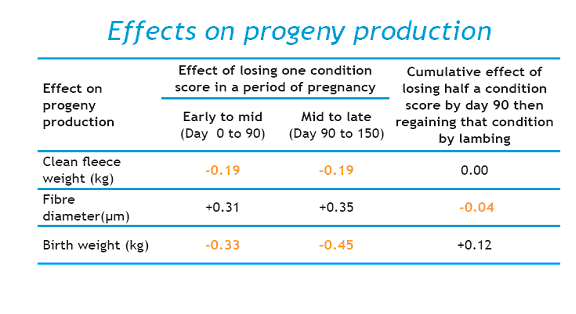|
Profitability
in Merino
enterprises

The
quantity and quality
of what sheep eat
(nutrition or energy
intake) controls
their fatness (body
condition), which in
turn directly
affects a number of
production factors
including lamb
survival and the
wool production of
both the ewe and her
progeny.
Pasture
availability
(largely driven by
rainfall) and the
nutritional needs of
the breeding ewe due
to advancing
pregnancy both
change throughout
the year. The demand
for energy by the
ewe peaks in early
lactation, hence
matching the time of
lambing to a time of
high pasture
availability,
allowing the
increased energy
needs of the ewe to
be met at a lower
cost.
Late
winter-spring
lambing in the high
rainfall zone
provides the best
match of pasture
availability to the
energy needs of the
ewe and lamb. This
match lifts pasture
utilisation and
allows stocking rate
to be increased
relative to lambing
at other times of
the year.
Higher
stocking rates will
increase the
production per
hectare and profit
per hectare,
although 'optimum'
stocking rate will
vary season to
season and farm to
farm within and
between regions.
Profitability at
Hamilton
in
Victoria
is
optimised when
pasture utilisation
is around 70%, due
to the long growing
season of the region
and the prevalence
of perennial pasture
species. At Kojonup
in
Western
Australia
farm
profit is optimal at
55% pasture
utilisation, due to
the increasing level
of supplementary
feeding needed to
maintain the
stocking rate over
the dry season.

Ewe
condition
has a
significant
effect
on
profitability
at any
stocking
rate.
Increasing stocking
rate without
adequate nutrition
for ewes may reduce
lamb survival and
wool production,
which in turn may
limit profitability.
Inadequate nutrition
can limit
profitability at any
stocking rate.
Before
fully understanding
the effects of ewe
condition on fleece
production and lamb
mortality, it was
assumed that running
ewes thinner and
losing more weight
over the autumn and
during pregnancy
meant more money
through savings in
feed costs.
Extensive
experiments and
economic analysis
have shown this
belief to be false
economy as there are
substantial
penalties for not
having ewes in good
condition by
lambing, and smaller
but significant
penalties for not
having ewes in good
condition for
joining. These
impacts must be
recognised when
evaluating the
financial
implications of
different management
strategies for ewe
flocks.

Condition
during
pregnancy
affects
the
progeny's
lifetime
production.
Ewe
condition
affects the
lifetime
performance of
her progeny.
Lamb
birth weight and
progeny fleece
value are
closely related
to ewe
condition,
particularly at
lambing.
Lamb
birth weight is
a strong
predictor of
lamb survival
and fleece value
of the
progeny .
During
pregnancy, the
effects of ewe
condition on
progeny wool
production and
birth weight
(and survival)
are generally
additive. That
is, the impacts
of nutrition in
early to mid
pregnancy can be
added to the
impacts of
nutrition in
late pregnancy.
Even though the
impacts appear
small at each
phase, they can
add up to a
large
impact on
profitability
for that
lambing. The
effects on
fleece value
are
permanent
for the
lifetime of
the lamb.
The table
below shows
the impacts
of changes
in condition
score over a
pregnancy.
For example,
the progeny
of ewes
maintained
at CS 3.0
throughout
pregnancy
might cut
3.5 kg CFW
(clean
fleece
weight) of
17 micron
wool. If the
same ewes
were to lose
condition so
that they
lambed in CS
2.0, their
progeny
would only
cut 3.1 kg
CFW of 17.4
micron wool
(ie less
wool that
was
broader).
Importantly,
losing condition
during early to
mid pregnancy
and then
regaining that
lost condition
by lambing time
gives the same
net result as
maintaining the
ewe's nutrition
over the whole
of the
pregnancy. For
example, the
progeny of ewes
maintained at CS
3.0 over
pregnancy might
cut 3.5 kg CFW
of 17 micron
wool but if the
same ewes lost
condition by day
90 and then
regained it to
be CS 3.0 at
lambing, the
progeny would
cut similar
quantity and
quality of wool.

It is
important to
note that the
impact on
progeny birth
weight is
greater in late
pregnancy than
in early to mid
pregnancy. Lamb
birth weight is
strongly related
to lamb
survival,
particularly in
twins (due to
their generally
lower birth
weight). Optimum
birth weights
are 4.5-6.0 kg
and survival
decreases
rapidly if lambs
are below 4.0
kg. Increasing
lamb birth
weight by 0.5 kg
from 3.5 kg to
4.0 kg in twin
lambs can mean
an increased
survival of
15%.
Tools:
ewe
management
guidelines
|